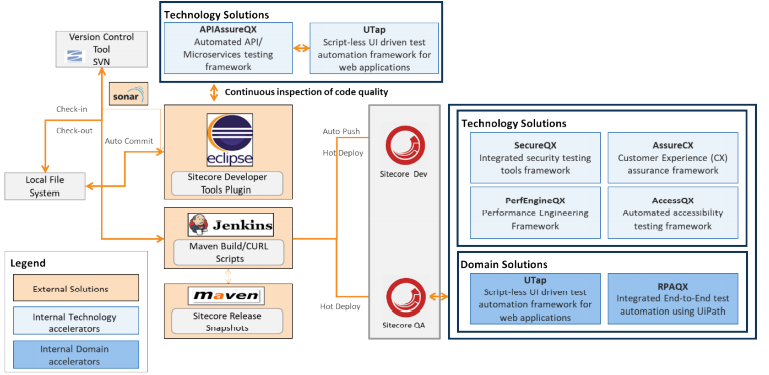Coforge blends internal IP and accelerators with external solutions that address specific technology or domain needs of the industry i.e.
- Open source development and testing tools and technologies i.e. Selenium, Eclipse, Jenkins etc.,
- Commercial development and testing tools and technologies i.e. Microfocus, Microsoft, Parasoft etc.,
- Horizontal digital platforms i.e. SAP, Mulesoft, Salesforce, Microsoft, Workday, Sitecore etc. and
- Vertical platforms i.e. Duckcreek (Insurance), Wealth Management (BFS), Sabre (Travel, Transporation & Hospitality) etc.
to provide end-to-end quality engineering services and solutions across agile, devops, iterative and waterfall development projects. We blend internal IP and accelerators with external solutions at technology level as well as domain level.
A. Technology level blending considerations. Below are our typical considerations to blend our internal IP & accelerators with external solutions for utilising their specific capabilities.
- Utilising libraries of external solutions to build capabilities i.e. screen scrapping, reporting, API testing etc. in our internal IP & accelerators.
- Executing actions in external solutions i.e. creating defect in Jira from our internal IP & accelerators.
- Orchestration of end-to-end test executions i.e. triggering Microfocus Fortify Static Code Analyzer, external solution, to identify exploitable security vulnerabilities in source code before triggering APIAssureQX, internal IP and accelerator, for API testing.
B. Domain level blending considerations. Below are our typical considerations to blend our internal IP & accelerators with external solutions i.e. vertical platforms for validating end-to-end business processes using
- Automation in Testing i.e. blending DCTQX, our suite of internal automation tools and utilities, with Duck Creek Technologies platform, external solution, to validate insurance business processes.
- RPA in Testing i.e. blending RPA, external solution, in continuous integration environment powered by internal IPs and accelerators and other external solutions.
Example: Blending internal IP & accelerators with external solutions to deliver automation infused testing services in a continuous integration environment
The below picture depicts implementation of Sitecore based insurance application. The application is a web platform which is used by customers for purchasing insurance. In summary, customers initially land on the web platform, browse through the product catalogue and generate a quotation. The next step is shop which upsells related products, ask the product questions, creates a customer profile and collects payment. The customers use their newly created profile to access the My Account section to view previous orders, download policy documentation and get in touch with their Account Manager.
The project has a continuous integration environment, with automated tests executed on a daily basis.

The insurance web platform is Sitecore based. The external solutions included, application in Sitecore, eclipse for development, Jenkins for continuous integration, Maven for build and deployment, SonarQube for static code testing and UiPath RPA tool.
Listed below are blending considerations of Internal IP and accelerators with external solutions to deliver automation infused testing services for this insurance web platform:
- Work Orchestration – Execution of internal IP and accelerators with external solutions in sequence. Example: Once Sonar tests pass on the integrated code, APIAssureQX tests are executed and on completion of which UTap scripts gets executed for UI based functional testing.
- Test Execution – Automated execution of test scripts from external solutions. Example: Once the new build is available in the QA environment, the automated test scripts are triggered automatically from the CI tool (Jenkins).
- Build Capability – Use of external solutions to build internal solutions. Example: UTap is developed over Selenium, PerfEngineQX uses performance testing tools such as jmeter, APIAssureQX is build using Karate open source libraries etc.
- Business Validations – We have developed, automated end-to-end business process validation leveraging RPA tool (UiPath). Business processes specific to the insurance application are created which traverses across integrating systems as well. Example: RPA automated test execution traverse through multiple systems for end-to-end validation of business process. First, it creates policy on the Sitecore application. The policy is then validated in the backend policy admin system and the policy artefacts are then validated in the document repository system. The RPA tool reads data from policy documents and validates the same in backend policy admin system.




